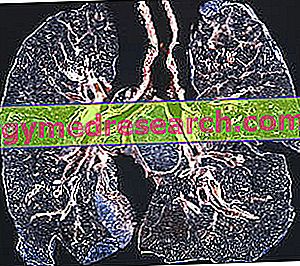What's this
Heparin is an anticoagulant active ingredient, capable - as such - of slowing down or interrupting the blood coagulation process; it is instead unable to promote the dissolution of already formed clots, which is otherwise favored by products of another pharmaceutical category, that of fibrinolytics .
What is it used for

The classic therapeutic applications of heparin are therefore represented by atrial fibrillation, deep vein thrombosis and acute coronary syndrome ( ischemic heart disease attack); its use is also indicated in patients undergoing major surgery and in dialysis patients (dialysis is a technique used to purify the blood when the kidneys are not functioning properly).
As regards in particular the use of heparin in deep venous thrombosis, the use of the medicinal product has essentially a preventive purpose and aims to prevent the formation of thrombus within the venous circulation. The most feared complication of this event is the so-called pulmonary embolism, resulting from the obstruction of an artery of the lungs by a fragment of thrombus detached from the clot, and then pushed by the blood to the right heart and from there to the pulmonary circulation.
Types of Heparin and Mode of Use
In therapy there is not a single heparin, but numerous types classified according to the "size" of the molecule that constitutes them. We therefore have low molecular weight heparins (smaller molecules) and standard or unfractionated heparins; the main difference between the two categories concerns the methods of administration.
Assuming that heparin cannot be administered orally (it would be digested, then inactivated) and that as such it must necessarily be injected, low molecular weight heparins can be administered subcutaneously, on a single daily occasion (a times two) and also in the home environment. The standard heparins, on the contrary, are administered intravenously, by infusion or several times a day, and their use is generally reserved for the hospital setting.
Both types of heparin possess a binding site with antithrombin III, a plasma glycoprotein with an anticoagulant action independent of vitamin K. This molecule - enhanced in its action up to 2000 times by binding to heparin - is able to inhibit different coagulation factors, in particular thrombin and factor Xa. While unfractionated heparin has an inhibitory activity both towards factor Xa and towards thrombin, low molecular weight heparins preferentially inactivate factor Xa.
How to inject it
Subcutaneous injections of heparin bpm (low molecular weight) must occur in areas that are well vascularized but far from the muscles; classically they are carried out at the level of the adipose tissue of the buttocks or of the anterolateral or posterolateral abdominal area. The injection is performed by lifting a fold of adipose tissue adequately disinfected between the fingers and orienting the needle in a perpendicular or slightly inclined direction depending on the thickness of the same.
After the injection, a cotton swab dipped in disinfectant must be pressed for a few seconds on the injection site, without rubbing. It is however essential to refer first of all to the indications received from your doctor, also regarding dosage, duration of therapy with heparin, frequency and mode of injection.
If you miss a dose
Should the patient miss a dose, for example due to forgetfulness, this should be done as soon as possible, unless it is near the time of the next injection; for no reason, in fact, a double dose of medicine must be injected. Also in this sense it is very important to respect the recommendations of the doctor, who must always be contacted in the presence of doubts or worrying symptoms: in the event of heparin overdose, there is in fact a real risk of going against more or less serious bleeding. In this regard it may be useful to set up a card in which to record the various injections according to the schedule established by the doctor.
Side effects
Interactions with other drugs
Heparin is a "delicate" drug in the sense that it must be used with particular care; there are also many possible interactions with other medicines. Even a trivial anti-inflammatory (ibuprofen, aspirin, diclofenac, ketoprofen etc.) for example, can potentiate the anticoagulant activity of the drug favoring the appearance of bleeding. Therefore, before taking any type of drug during heparin therapy it is very important to get the preventive preventive from the doctor; the same applies to herbal supplements and preparations.
Important Recommendations
Particular attention should also be paid to avoiding more or less serious traumatic episodes (from contact sports to too vigorous tooth brushing).
Small bleeding can occur not only during therapy, but also for a few weeks after it ends; the doctor must be immediately alerted in the presence of diffuse hematoma, difficulty in stopping the loss of blood from the nose (epistaxis), blood in the urine (hematuria), blackish, tarry stools or with obvious traces of blood and important gingival bleeding.
Contraindications
Absolute contraindications to the use of heparin are represented by thrombocytopenia, on-going bleeding syndromes and by the existence of allergic phenomena (for example hypersensitivity to substances of porcine origin or to heparin itself). Caution during the menstrual period and in the presence of liver, intestinal or gastric diseases, uncontrolled hypertension, coagulation disorders and blood diseases (eg hemophilia).
During the medical interview that is a prelude to the beginning of the therapy it is also important to expose a possible state of pregnancy, for which the absolute safety of heparin has not yet been established.



